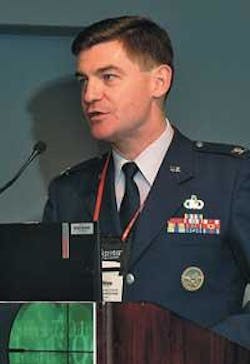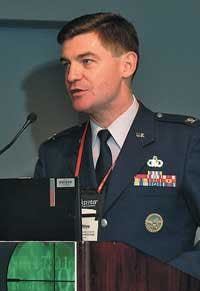Col. Gary Connor helps transform C3ISR technology
U.S. Air Force Col. Gary S. Connor is head of the Command and Control, Intelligence, Surveillance, and Reconnaissance Systems (C2ISR) Wing of the Air Force Electronic Systems Center based at Hanscom Air Force Base, Mass. Connor, who is a brigadier general select, is in charge of transforming Air Force and U.S. joint force technologies that help with leading and controlling offensive and defensive forces, provide crucial tactical intelligence to help U.S. and allied warfighters move quickly and effectively against enemy forces, and that persistently watch enemy forces for useful information. He is a graduate of the Defense Systems Management College Program Management Course, the Defense Acquisition University’s Senior Acquisition Course, and he is a designated member of the Defense Acquisition Workforce. Connor is also Certified Level III in program management and is a qualified joint specialty officer.
Q. How do you define force transformation, and what are some of the most common misconceptions?
A. Transformation is really about thinking differently, and about connecting existing things in different ways to achieve new capabilities. Sometimes there is a revolutionary capability, like stealth or the Global Positioning System that will help with transformation, but more often than not it is about taking the stuff we already have and using it indifferent ways to achieve different outcomes.
Examples of this are taking video from the Predator unmanned aerial vehicles and integrating that video on an AC-130 gunship to give the AC-130 crew a way of precision targeting. Another example is taking Predator video and providing it to the special operations folks. You could have special-ops people riding horseback through the desert, and using Predator video on their laptop computers or PDAs to see what is over the other side of the next hill. This is what we mean by “power to the edge.”
You also could take Global Hawk unmanned aerial vehicle data, and use that aircraft as a server in the sky to collect terabytes of data and send just the right information down to the special-ops guy with the PDA. PDAs today are not revolutionary in themselves, but are involved in the process to connect these capabilities together.
Q. What are some of the most important issues today concerning transformational C2ISR?
A. We have made tremendous strides in integrating command, control, and intelligence capabilities. Where we were in Desert Storm compared to where we are today is an order of magnitude or better.
We have three planes of interest: technological; concept of operations (ConOps), or how we operate; and acquisition strategy and budget.
On the technology side, the industry folks are really stepping up to the plate to help us think through what needs to be integrated, with regard to data standards, architectures, and so on. We still have the market focus on the division of proprietary and commercial technologies. By and large the industry gets it, in where we are heading.
In ConOps we are creating an environment that enables our operators to dynamically evaluate new capabilities. We have the contractor laboratories, and user environments with training and simulation. We need to connect the labs with simulation and training to try out new techniques. But these things are products of our budget and resources.
We are taking a singular systems look at how to broaden that capability to a representation of the operational architecture. One of these is the Distributed Mission Operations and Distributed Mission Training initiative. We are extending this initiative to allow industry and government organizations to bring products and technologies to the table first at the systems level, and then at the systems-of-systems level. Things are not always about a new capability. Unless you can work in those operating environments, it limits your degrees of freedom.
The acquisition process and enablers start with the budget and the ability to fund programs. We are still funding our programs individually, rather than looking at overall capabilities. We are having the capabilities discussion, but are still funding as individual programs, and we still nave not mastered the translation function to help us articulate how programs and capabilities work together.
The joint operations process helps drive some coherency across our programs, and to help translate programs into capabilities, but our success depends on how we will work with the joint commands to see how we will conform to their views.
Q. What do you need most from Industry?
A. The key is having the industry folks articulate their solutions in an operational context. Industry needs to get into the heads of the operators. It is important for the widget guys to articulate in the larger context. That may mean partnering with the large prime contractors to help determine the operational concepts for their widgets.
We also need the big guys to take some of the smaller guys under their wings to help them put products into an operational context.
We need industry to think about being first-to-market. Speed is king in the business world, and is just as important in today’s defense world. Incremental improvements are okay, but you just have to get the darned things out to the field so the people in the field can determine the utility of the thing.
Industry needs to let the users determine what the next developmental or upgrade spiral is, not the engineer who designed it. We need to demonstrate products and capabilities in ways like using the Distributed Mission Training Environment at Langley Air Force Base, Va.
A good place to start is Kenneth Callicutt, the technical director for the C2ISR Center at Langley Air Force Base. A lot of prime contractors are active players in those kinds of distributed environments. (Editor’s note: Kenneth S. Callicutt is a member of the Senior Executive Service, and is Senior Technical Director of the Air Force Command and Control, and Intelligence, Surveillance and Reconnaissance Center at Langley Air Force Base, Va.)

